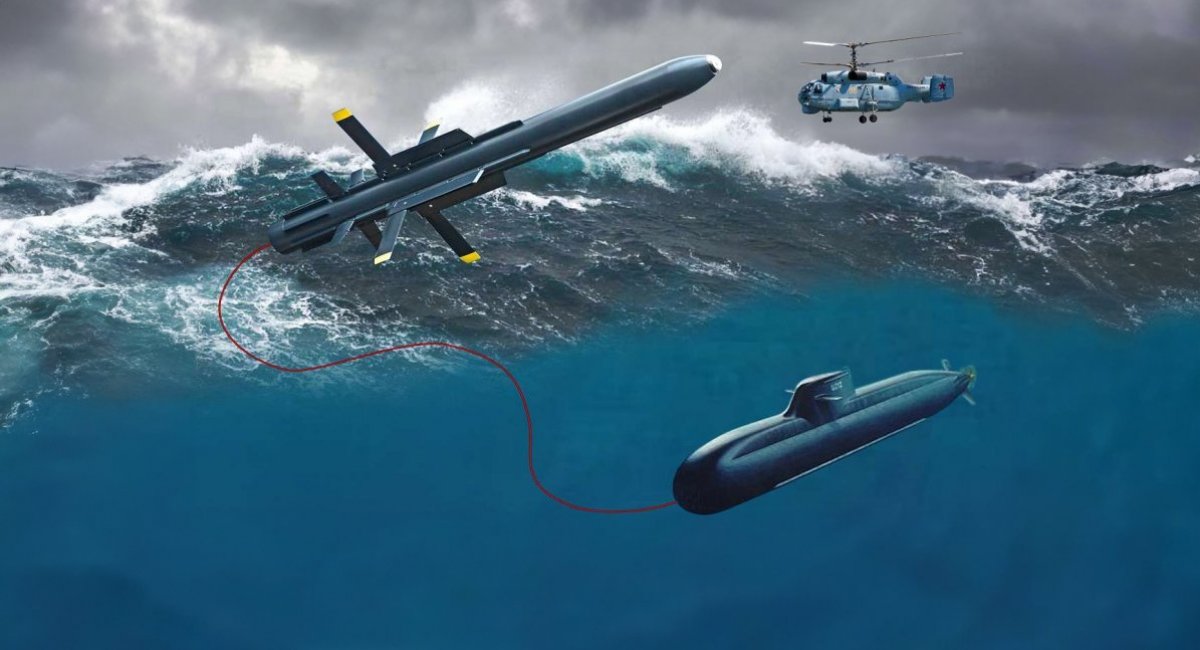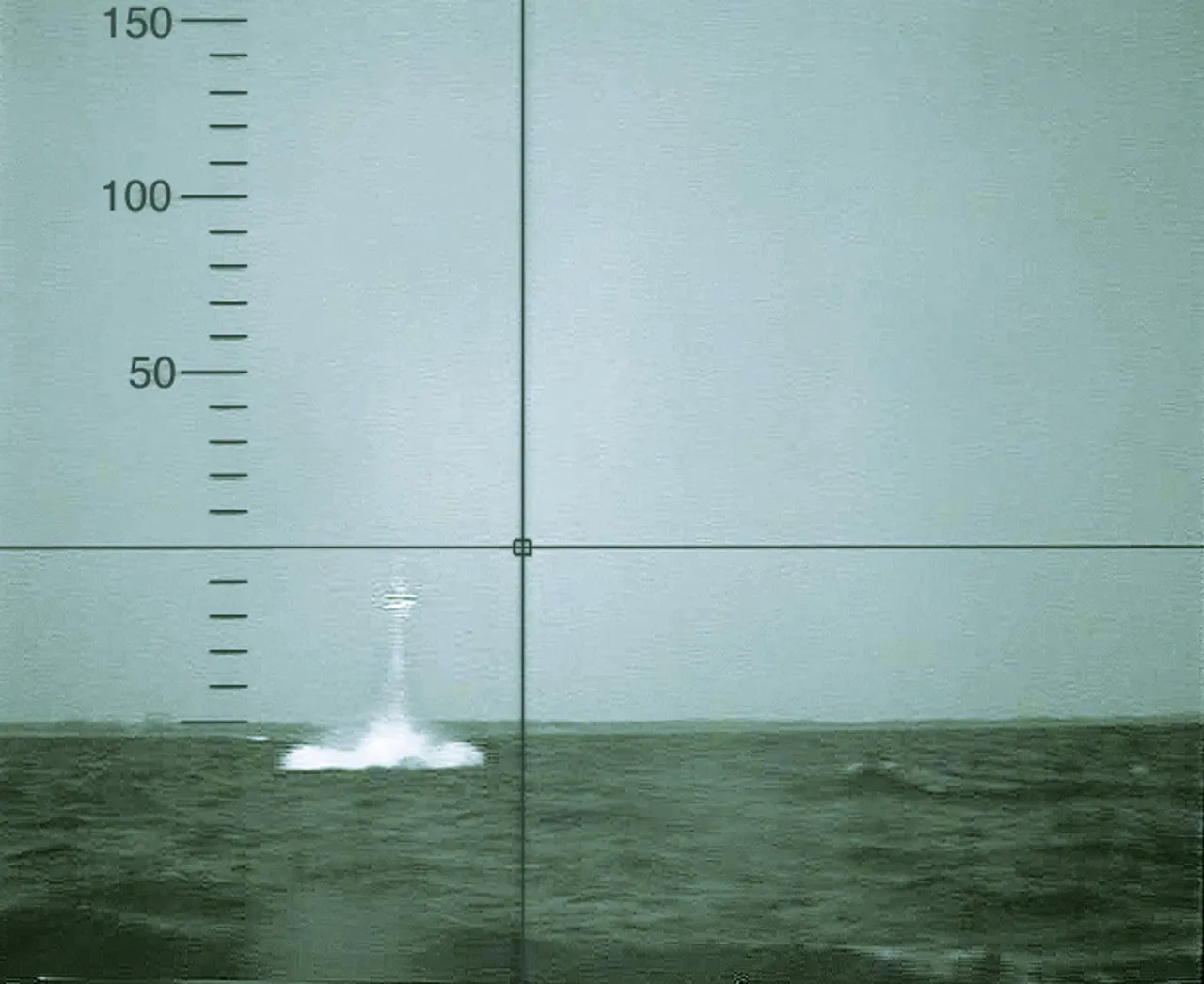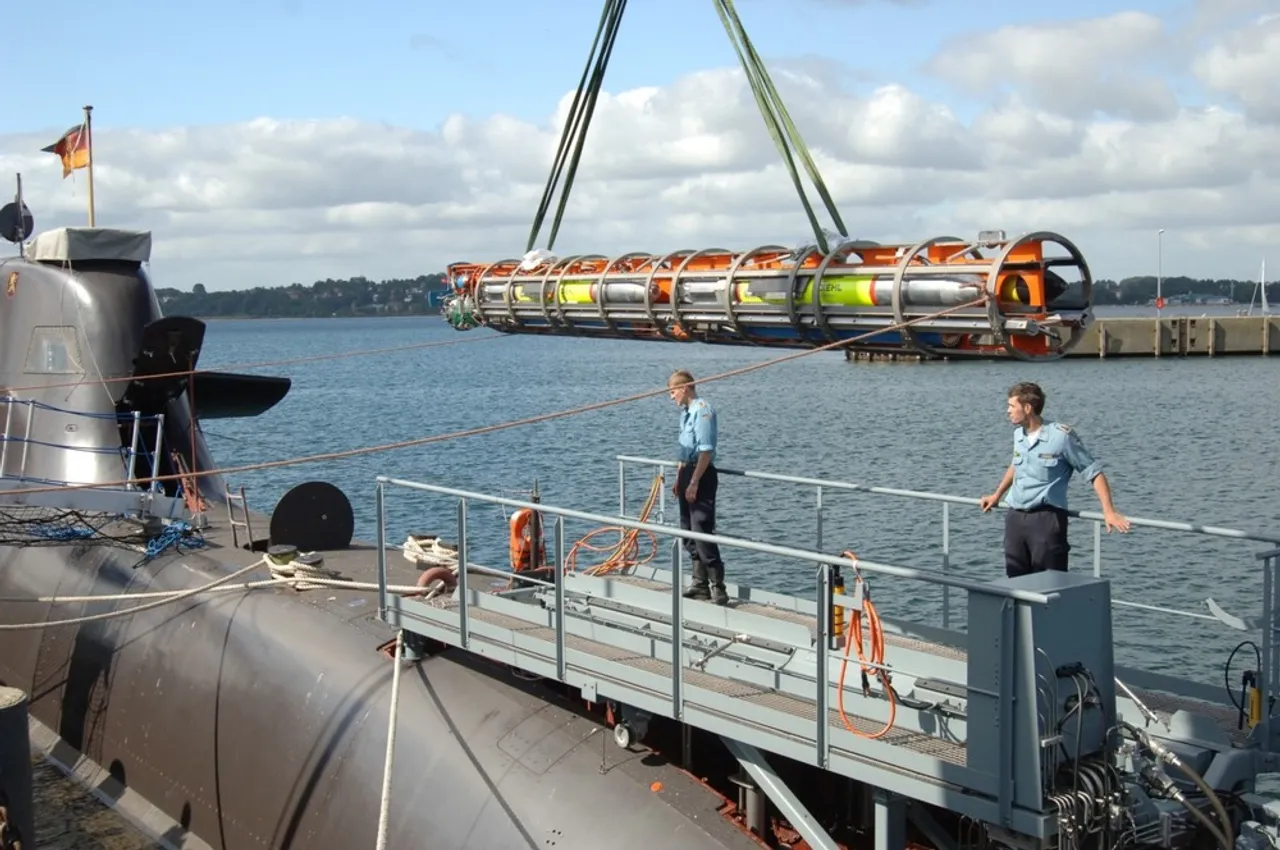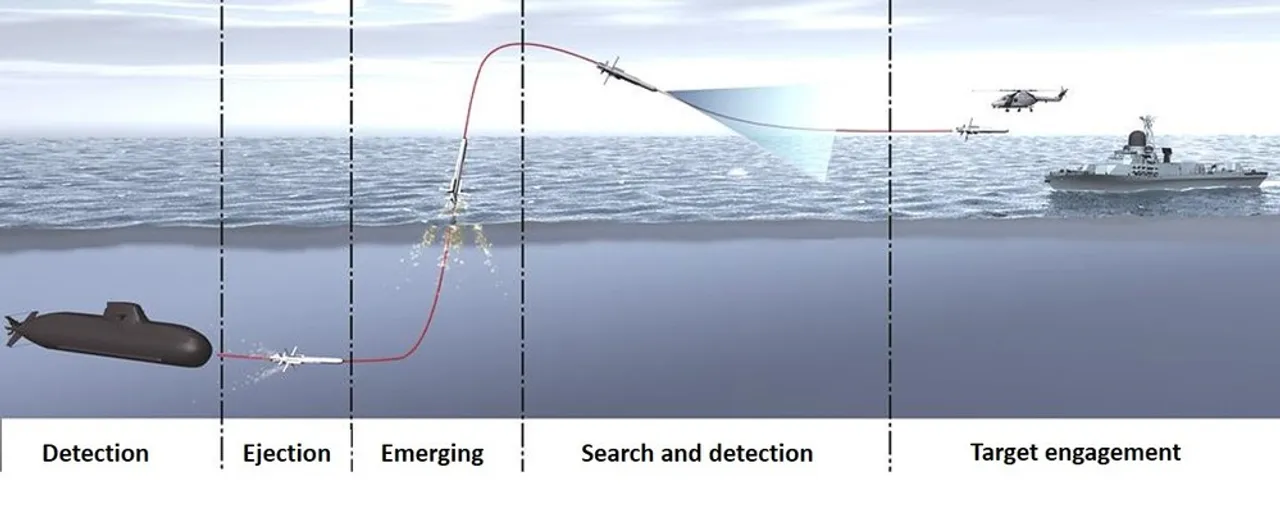Svetlana
Shcherbak for Ukraine based Defense Express has written an excellent article
on what is possibly? the world’s first anti-aircraft missile that
can be launched from a fully submerged submarine. The article
is dated January 26, 2025 and is at https://en.defence-ua.com/weapon_and_tech/30_years_of_idas_development_germanys_underwater_anti_aircraft_missile_to_counter_russian_helicopters_was_it_worth_it-13319.html.
Pete Comment
The submarine launched variant of the in service since 2005 IRIS-T missile has been a long time in (mainly German) development. This may be due to years perfecting the submarine variant's necessary fiber optic cable
link. This link must be able to survive the missile’s surfaced sudden
acceleration and the blast of the rocket motor. Hence the submarine variant missile’s velocity
and rocket blast have been reduced by the developers.
The marginal nature of IDAS as a weapon of last resort, in very shallow water, might mean a limited Baltic market (Germany, maybe Norway, with Sweden as a less likely adopter).
ARTICLE
"30 Years of IDAS Development: Germany’s Underwater Anti-Aircraft Missile to Counter Russian Helicopters – Was It Worth It?

Germany has entered the final stage of developing the
IDAS submarine-launched surface-to-air missile, a project initiated in the
2000s to defend against Russian anti-submarine helicopters [and rotary wing
drones large enough to carry lightweight torpedoes].
The German company [tkMS, on January 24 2025, announced] the signing of a contract with the Bundeswehr’s Procurement Department (BAAINBw) to complete the development and qualification of the Interactive Defence and Attack System for Submarines (IDAS). This unique missile is designed to engage aerial targets while the submarine remains submerged.
The contract stipulates that development and qualification work must be completed by the end of 2029. This means that the creation of IDAS will have taken over 30 years, as initial test trials were conducted in 2003, and the first underwater launch occurred in 2008. Although the project saw active progress in the 2000s, development slowed significantly over time.

The new contract aims to restart active work and finally bring the project to completion, enabling Germany’s Type 212 [As and CDs] submarines to effectively counter Russian anti-submarine helicopters. Notably, IDAS is being developed by tkMS and Diehl Defence in cooperation with Norway’s Kongsberg and Nammo, as well as Turkey’s Roketsan. This international collaboration highlights the complexity of developing such an advanced anti-aircraft missile, even though it is based on a deep modification of the IRIS-T air-to-air missile.
In general, IDAS will allow submarines to engage low-altitude, slow-moving aerial targets—such as anti-submarine helicopters—at a range of up to 15 kilometers. Additionally, the system is capable of engaging surface and ground targets. However, its speed of 200 m/s is relatively low for an anti-aircraft missile. For comparison, the IRIS-T, on which it is based, reaches 1,020 m/s. Despite this, IDAS is well-suited for self-defense in shallow waters against helicopters equipped with torpedoes and sonar systems.
The IDAS missile is stored and launched from a 533-mm torpedo-sized container, allowing integration into existing submarines without major structural modifications. Each container holds four missiles, along with launch control electronics and an interface system.

Aerial target detection and tracking rely on the submarine’s onboard acoustic sensors. The missile has a solid-fuel engine, which activates at a safe distance from the launch platform.
Once launched, IDAS manoeuvres underwater toward its target. As it nears, it surfaces, deploys aerodynamic control surfaces, and proceeds to engage.
During its cruise phase, the missile is controlled and guided via a fiber-optic cable. In the terminal phase, it locks onto the target using an infrared seeker before striking.

Throughout its flight, the operator [in the submarine] can control the missile and receive live footage from its onboard camera, allowing target identification and prioritization of the most critical threats. If the fiber-optic cable is severed, the missile—depending on preset parameters—either autonomously selects and engages the most likely target or self-destructs to avoid unintended damage.
For submarines, IDAS is essentially a last-resort weapon, designed for situations where a submarine is trapped in shallow waters and unable to dive deep to evade detection. In such cases, IDAS provides a critical defense against airborne threats, ensuring that submarines are not left completely vulnerable."

12 comments:
https://timesofindia.indiatimes.com/india/ministry-of-defence-to-hold-talks-with-mazagon-docks-german-co-for-6-submarines/articleshow/117499750.cms
It looks the latest 75I SSK might go in favour of the Mazagaon Docks TKMS combo for the U-212 derivative (U-214?) with 6 sub plus 3 optional order. The Navantia one failed the AIP operational at sea criterion apparently while the TKMS sub with its decades long operational record won out.
Ideally the IN should order 9-12 SSKs to be delivered at 18 month intervals even if the first 1-2 boats need to be built at Kiel. The pakistanis egged and equipped by the chinese will have 4 new Stirling AIP subs by 2028.
The requirement for such a weapon presumably stems from Germany operating its submarines in the comparatively shallow Baltic Sea. Back in the 1970s Shorts of Belfast built a prototype system using the Blowpipe missile on an extendable mast (SLAM). This was tested aboard HMS Aeneas, but I understand it was rejected by the RN on the grounds that its use would generate too obvious a signature. Some sources suggest that it was used by Israel for a time.
Even allowing for the much extended range of IDAS one does wonder if the same strictures apply and efforts to conceal a submerged boat might be more productive.
Hi Ghalib Kabir at 1/28/2025 8:19 PM
The long troubled Project 75I process may well falter again. The sale of 6 x Type 214s to India might fall down on India's penchant for haggling and any expectation TKMS has to accept unlimited liability.
Also TKMS might hesitate at fully integrating its AIP if that risks exposure to the many Russian advisers or agents involved in supplying India with arms and designs for decades. More likely 214s than low magnetic steel 212 technology due to risk of steel ToT to Russia.
https://timesofindia.indiatimes.com/india/ministry-of-defence-to-hold-talks-with-mazagon-docks-german-co-for-6-submarines/articleshow/117499750.cms talk of AIP for Scorpene might be unrealistic given France has not fully (sea) tested any other AIP than decades old, obsolete, MESMA.
Pakistan appears to be improving on its 3 Agosta MESMA subs with 8 x Stirling AIP Yuans on the way.
Navantia, with no operational AIP S-80 Plus until 2028 https://en.wikipedia.org/wiki/S-80_Plus-class_submarine#Ships_of_the_class was no real competition.
Cheers Pete
Hi Anonymous at 1/29/2025 7:00 AM
Thanks for the info on part surfaced UK Blowpipe missile efforts.
Yes, the marginal nature of IDAS as a weapon of last resort might mean a limited Baltic market (Germany maybe Norway with Sweden as a less likely adopter).
If the IDAS concept was attractive then navies with many SSKs in the past, like the US or Russia, would have developed their own.
There is a risk of countermeasures in that an ASW helicopter or large drone would have sensor software to automatically launch a smart/homing LWT if an IDAS were launched.
The sub relying on submerged stealth would indeed be current doctrine. Also small anti-torpedo torpedoes or decoys are available.
Cheers Pete
Naval Group has stopped since 2019 to propose (and complete the sea trial )of its second gen AIP FC 2G(fuel cells and reforming of gas oil) although an onshore facilty had been operating sucessfully
NG believes that full Li batteries (LlFe PO4, SAFT)is the way to go.The now marginal advantage of AIP over Li in duration of submerged operations, is offset by its constraints (complexity , maintenance ,cryogenic gas at sea,very low speed..)and added weight ,volume/vs more li batteries that can be reloaded faster now
Clearly , the recent Dutch,Indonesian,Japanese(Brazilian and Australian before..!) did not choose the AIP option offered to them.It is likely that the 3 additional Scorpene will be of the Li "evolved" type.
A comparaison of the tactical situations enveloppes, relevant to India, of the e Scorpene , (probably ordered within the next weeks),and the TKMS projetfor P75 i woul be intersting
Hi (probably French) Anonymous at 1/29/2025 8:26 PM
In 2019 NG claimed progress in its AIP FC 2G. See https://www.navalnews.com/naval-news/2019/07/naval-group-achieves-breakthrough-with-its-fc2g-aip-system/ and Mer et Marine via
https://gentleseas.blogspot.com/2019/10/naval-groups-2nd-generation-fuel-cell.html
But thanks for advice NG is turning to Li ion batteries (LIBs) as its long submergence offering.
True. The marginal advantage of all AIP technologies are impeded by the necessary heavy large cryogenic Liquid Oxygen (LOx) tanks.
Japan discontinued Stirling AIP in its later Soryu Mark 2s mainly because of the LOx problems. As LOx was used up they would become a shifting ballast problem. Then become a dead weight (along with all other AIP components) once the LOx was fully used up.
So Japan turned to LIBs in its most recent Taigei class.
Basically the longer range a nation's submarine patrol patterns, the less useful AIP is. The Dutch and Australia have very long range patterns. Brazilians and Japanese medium-long range. Indonesia medium range.
Cheers Pete
[Off topic news]
Our Best Look Yet At Britain’s New Dreadnought Class Ballistic Missile
Submarine Design
"A detailed model has provided what’s likely our best idea of how the U.K. Royal
Navy’s new Dreadnought class nuclear ballistic submarine, or SSBN will
appear. The four Dreadnought boats represent one of the most important U.K.
defense programs in many years and it’s notable to see how many advanced
features the design includes, as the Royal Navy seeks to find the optimum
balance between speed, stealth, and incredibly destructive firepower. The four
new SSBNs (known as ‘bombers’ in British parlance) will replace the Vanguard
class that entered service in the 1990s."
Source:
https://www.twz.com/sea/our-best-look-yet-at-britains-new-dreadnought-class-ballistic-missile-submarine-design
That Time russia Wanted Own IDAS Missile Analog For Submarines, and How
the Project Ended:
"All in all, every russian attempt to develop an anti-aircraft missile system for
submarines ended in failure, despite the complexity of designs going down a
notch every time until it ruined the whole point of making this weapon."
See:
https://en.defence-ua.com/analysis/that_time_russia_wanted_own_idas_missile_analog_for_submarines_and_how_the_project_ended-13393.html
Thanks Anonymous at 2/01/2025 7:34 AM
The early model of the UK's Dreadnought class SSBN at https://www.twz.com/sea/our-best-look-yet-at-britains-new-dreadnought-class-ballistic-missile-submarine-design might also give an idea what the mainly UK designed SSN-AUKUS might look like.
SSN-AUKUS is likely to have a considerably smaller beam than the Dreadnought class. This would be made possible if the PW3 (or maybe PW4) reactor can be sufficiently miniaturised. Another beam definer would be the length/height of the vertically launched hypersonic missiles going into SSN-AUKUS - most likely in the 2040s.
Regards Pete
[Off topic news]
New Chinese submarine:
"Preliminary estimates suggest that the new submarine is around 45 meters
(148 feet) long and 5 meters (15 feet) across. The most notable features are
the large X-form rudders at the stern, and the apparent absence of a sail. Sails
are a standard feature but designers have sought ways to eliminate them to
create a more streamlined boat. China is so far the only country to have built a
sailless submarine, with one launched at the Jiangnan Shipyard in Shanghai in
2019."
Source:
https://www.navalnews.com/naval-news/2025/02/new-unreported-submarine-in-china-leaves-west-guessing/
Thanks Anonymous at 2/02/2025 4:06 PM
https://en.defence-ua.com/analysis/that_time_russia_wanted_own_idas_missile_analog_for_submarines_and_how_the_project_ended-13393.html "That Time russia Wanted Own IDAS Missile Analog For Submarines, and How the Project Ended" of February 2, 2025 is very useful.
As russia is committing much of its defense budget to the violation of Ukraine even less money is available for submarine innovation and components development.
Most submarine funds go to russian nuclear sub development and construction. The money remaining is too little to develop an efficient russian AIP system. russia's under-developed version of IDAS has been assigned even lower priority.
Hi Anonymous at 2/04/2025 5:57 AM
This report https://www.navalnews.com/naval-news/2025/02/new-unreported-submarine-in-china-leaves-west-guessing/ of a new Chinese XLUUV appears a little credulous.
What is the proof it is manned?
A manned submarine cannot operate without a sail for security and safety reasons when leaving and entering harbours.
Regards Pete
Post a Comment